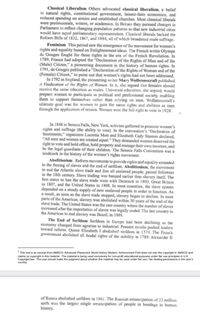Question
thumb_up100%
What does this source tell you about Liberalism, Feminism, Abolitionism, and the Abolition of Serfdom?
This is history.

Transcribed Image Text:Classical Liberalism Others advocated classical liberalism, a belief
in natural rights, constitutional government, laissez-faire economics, and
reduced spending on armies and established churches. Most classical liberals
were professionals, writers, or academics. In Britain they pursued changes in
Parliament to reflect changing population patterns so that new industrial cities
would have equal parliamentary representation. Classical liberals backed the
Reform Bills of 1832, 1867, and 1884, all of which broadened male suffrage.
Feminism This period saw the emergence of the movement for women's
rights and equality based on Enlightenment ideas. The French writer Olympe
de Gouges fought for these rights in the era of the French Revolution. In
1789, France had adopted the "Declaration of the Rights of Man and of
(Male) Citizen," a pioneering document in the history
1791, de Gouges published a "Declaration of the Rights of Woman and of the
(Female) Citizen," to point out that women's rights had not been addressed.
In 1792 in England, the pioneering writer Mary Wollstonecraft published
A Vindication of the Rights of Women. In it,
receive the same education as males. Universal education, she argued, would
prepare women to participate in political and professional society, enabling
them to support themselves rather than relying on men. Wollstonecraft's
ultimate goal was for women to gain the same rights and abilities as men
through the application of reason. Women won the full right to vote in 1928.
the
of
human
rights. In
argued that
females should
she
In 1848 in Seneca Falls, New York, activists gathered to promote women's
rights and suffrage (the ability to vote). In the convention's "Declaration of
Sentiments," organizers Lucretia Mott and Elizabeth Cady Stanton declared,
"All men and
right to vote and hold office, hold property and manage their own incomes, and
be the legal guardians of their children. The Seneca Falls Convention was a
landmark in the history of the women's rights movement.
are created equal." They demanded women deserved the
Abolitionism Reform movements to provide rights and equality extended
to the freeing of slaves and the end of serfdom. Abolitionism, the movement
to end the Atlantic slave trade and free all enslaved people, gained followers
in the 18th century. Slave trading was banned earlier than slavery itself. The
first states to ban the slave trade were with Denmark in 1803, Great Britain
in 1807, and the United States in 1808. In most countries, the slave system
depended on a steady supply of new enslaved people in order to
a result, as soon as the slave trade stopped, slavery began to decline. In most
parts of the Americas, slavery was abolished within 30 years of the end of the
slave trade. The United States was the rare country where the number of slaves
increased after the importation of slaves was legally ended. The last country in
the Americas to end slavery was Brazil, in 1888.
function. AS
The End of Serfdom Serfdom in Europe had been declining as the
economy changed from agrarian to industrial. Peasant revolts pushed leaders
toward reform. Queen Elizabeth I abolished serfdom in 1574. The French
govemment abolished all feudal rights of the nobility in 1789. Alexander II
* This text is an excerpt from AMSCO: Advanced Placement World History Modem. Achievement First does not own the copyright in AMSCO and
claims no copyright in this material. The material is being used exclusively for non-profit educational purposes under fair use principles in U.S.
Copyright law. The user should make the judgment about whether this material may be used under fair use / fair dealing permissions in the user's
country.
of Russia abolished serfdom in 1861. The Russian emancipation of 23 million
serfs was the largest single emancipation of people in bondage in human
history.
Expert Solution
This question has been solved!
Explore an expertly crafted, step-by-step solution for a thorough understanding of key concepts.
Step by stepSolved in 2 steps
